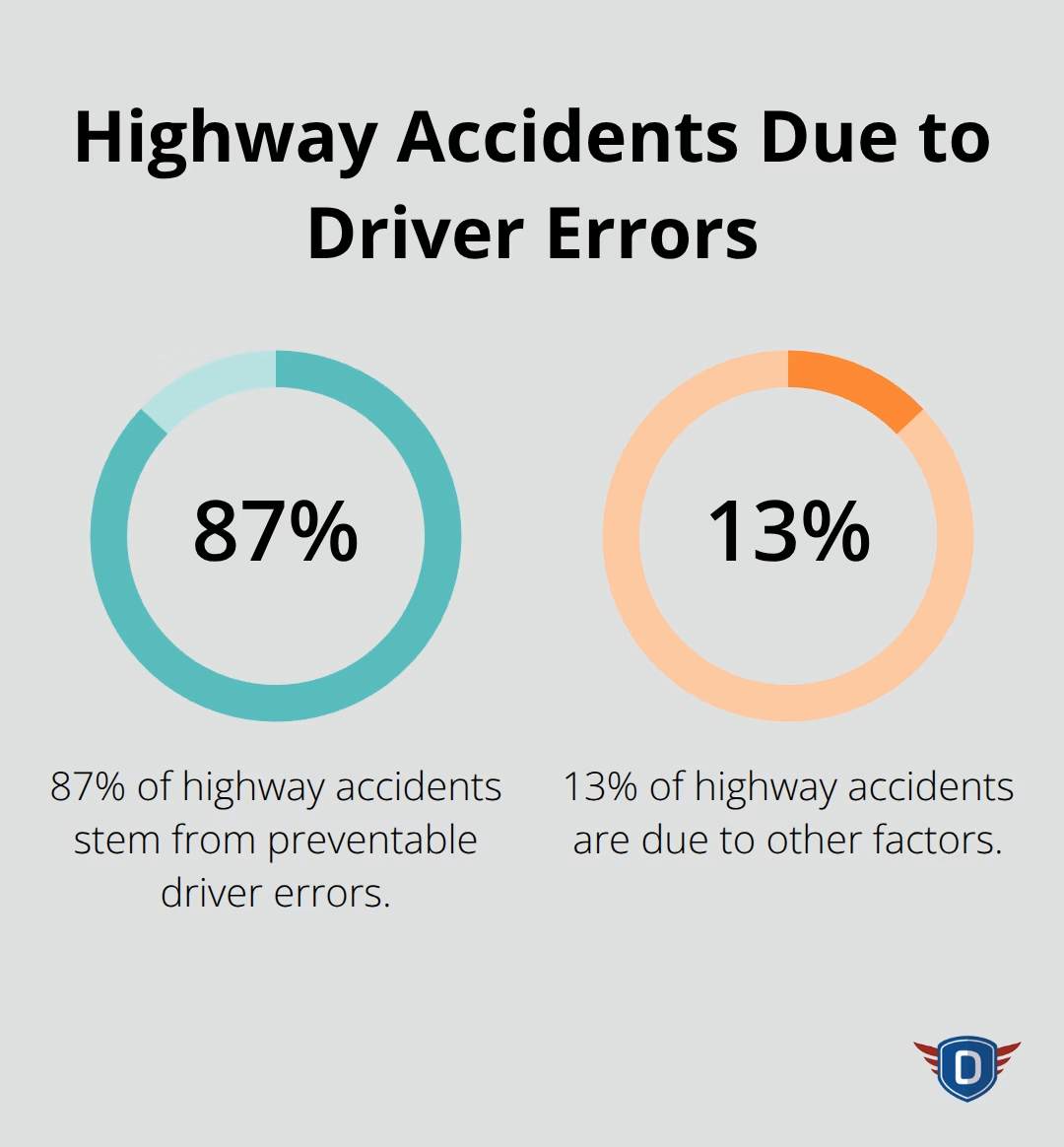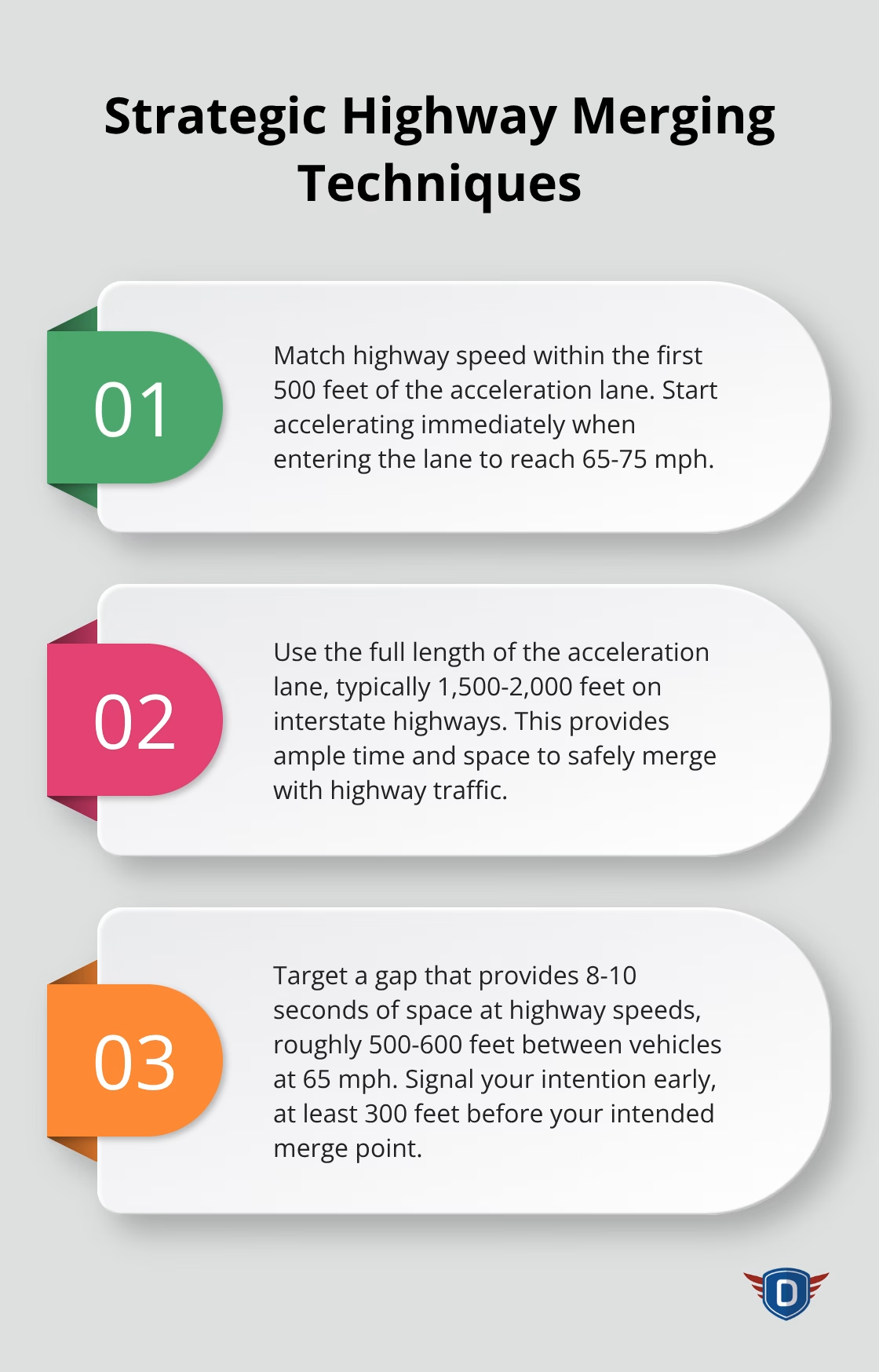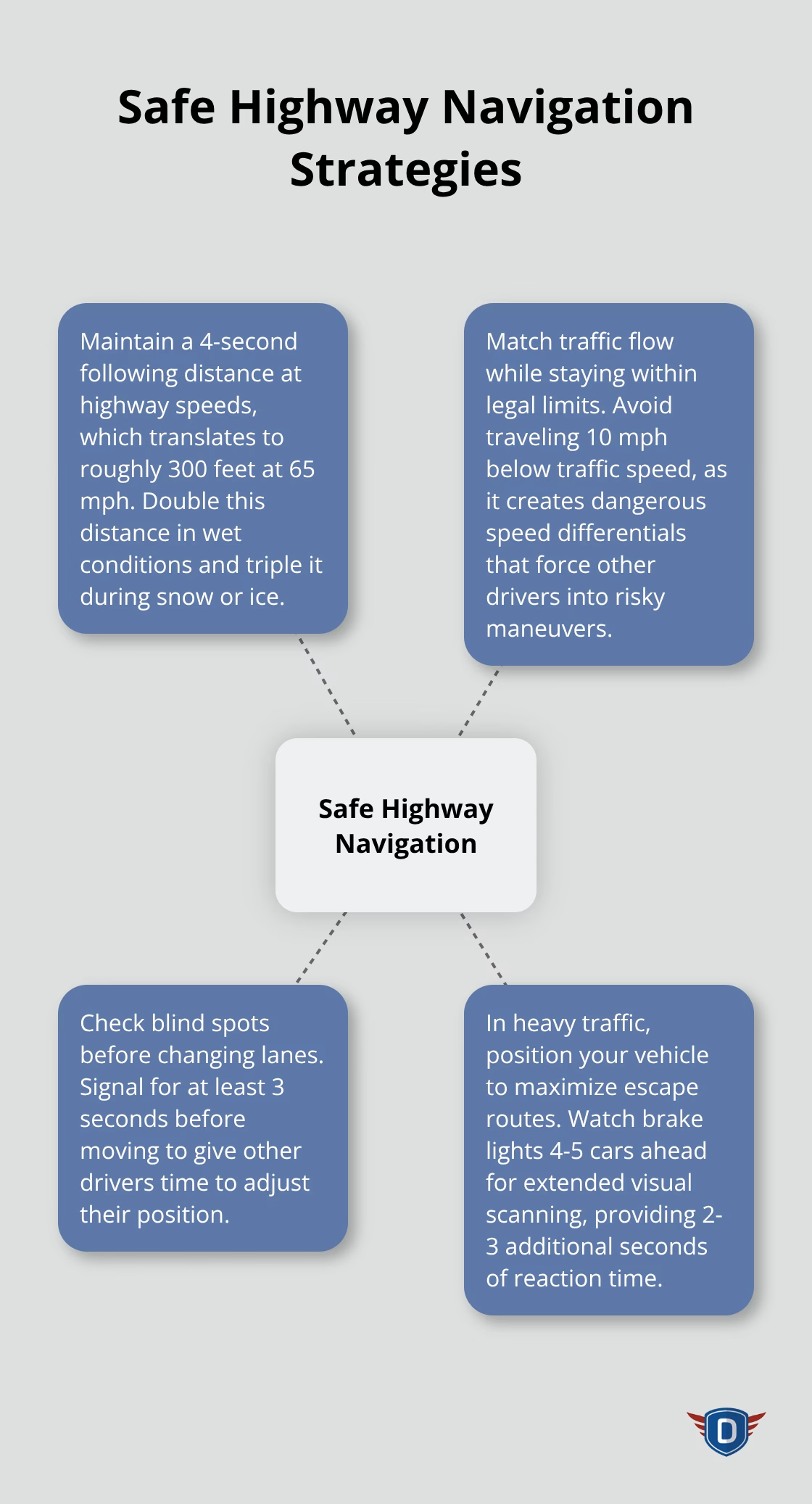Highway driving presents unique challenges that require specific skills and preparation. According to the National Highway Traffic Safety Administration, 52% of traffic fatalities occur on highways and interstates.
We at DriverEducators.com believe mastering safe highway driving techniques can dramatically reduce your risk on the road. This guide covers everything from pre-trip preparation to advanced defensive strategies.
Essential Highway Preparation Steps
Proper highway preparation separates confident drivers from anxious ones. The Federal Motor Carrier Safety Administration reports that 87% of highway accidents stem from preventable driver errors, which makes thorough preparation your strongest defense against becoming a statistic.

Vehicle Safety Inspection Protocol
Your vehicle inspection should follow a specific 5-minute routine that catches 95% of potential mechanical failures. Check tire pressure with a digital gauge – poor tire maintenance can lead to premature tire wear, flat tires, or even blowouts. Test your brakes by pressing the pedal firmly before you start your engine. The pedal should feel solid and stop halfway to the floor.
Inspect windshield wipers, headlights, and turn signals. Replace wiper blades every 6 months regardless of appearance since highway speeds amplify visibility issues. Check fluid levels including oil, coolant, and brake fluid. Low brake fluid creates a 40% longer stopping distance at highway speeds.
Mental and Physical Readiness Assessment
Your reaction time increases by 50% when fatigued, which makes physical readiness non-negotiable. Research shows that drowsy driving poses significant risks, with the public’s perceived risk notably lower compared to drunk driving. Schedule highway trips between 10 AM and 2 PM when alertness peaks naturally.
Avoid driving during your body’s natural fatigue periods from 2-4 PM and midnight-6 AM. Take a 15-minute break every 2 hours during long trips. Eat light meals before you drive since heavy foods increase drowsiness by 25%. Skip medications that cause drowsiness – even allergy medications can impair safe night driving performance.
Route Planning and Weather Strategy
Weather conditions change highway dynamics completely. Rain increases stopping distances by 25% while snow can triple them making advance planning essential. Check weather forecasts along your entire route, not just departure and arrival points. Use weather radar apps to identify storm systems 2-3 hours ahead.
Plan alternate routes before departure since GPS systems often fail to account for weather-related delays. Download offline maps as backup since cell coverage drops in rural highway areas. Monitor traffic patterns with real-time apps – highway congestion increases accident risk by 40% during peak hours.
Once you complete these preparation steps, you’ll need to master the technical skills that separate novice highway drivers from experienced ones. The next phase focuses on acceleration lanes, merging techniques, and exit strategies that keep traffic flowing smoothly.
How Do You Master Highway Entry and Exit Maneuvers
Acceleration Lane Mastery
Acceleration lanes serve one purpose: you reach highway speed before you merge. Highway merge maneuvers present significant safety challenges, with speed differential as the primary cause of accidents. Most drivers make the fatal mistake of entering acceleration lanes at 35-45 mph when highway traffic moves at 65-75 mph. This 30 mph speed gap creates dangerous situations that force other drivers to brake suddenly.
You must start acceleration immediately when you enter the acceleration lane. Your goal is to match highway speed within the first 500 feet of the lane. Use the full length of the acceleration lane (typically 1,500-2,000 feet on interstate highways). Never stop in an acceleration lane unless traffic completely blocks your path. Stopping transforms a manageable merge situation into a high-risk scenario where you must accelerate from zero while other vehicles approach at highway speeds.

Strategic Merge Techniques
Successful merges require precise timing and spatial awareness. Research from the Insurance Institute for Highway Safety indicates that merge-related crashes increase by 60% during peak traffic hours. Position your vehicle in the acceleration lane’s center to maximize your visibility to highway drivers. Check your mirrors continuously but focus 80% of your attention on the gap you plan to enter.
Target a gap that provides 8-10 seconds of space at highway speeds. This translates to roughly 500-600 feet between vehicles at 65 mph. Signal your intention early – at least 300 feet before your intended merge point. Adjust your speed to match the gap’s timing rather than force your way into inadequate spaces. Highway drivers have the right of way, which makes it your responsibility to find appropriate entry opportunities.
Exit Preparation and Speed Control
Exit ramp navigation begins 2 miles before your departure point. Highway crashes involving exit preparation present ongoing safety concerns for traffic engineers. Move to the right lane early to avoid last-minute lane changes across multiple traffic streams. Late lane changes cause chain-reaction accidents when drivers brake suddenly to accommodate your movement.
Begin speed reduction only after you enter the deceleration lane. Maintain highway speed in the through lanes to prevent traffic disruption. Most exit ramps require 25-35 mph speeds compared to 65+ mph highway speeds. Use the full deceleration lane length to reduce speed gradually. Sharp curves on exit ramps can cause rollovers at speeds above 45 mph (particularly in SUVs and trucks). Check your speedometer frequently during deceleration since your perception of speed changes after extended highway travel.
These entry and exit techniques form the foundation of highway safety, but maintaining that safety requires mastering the complex dynamics of high-speed traffic flow and defensive positioning strategies.
How Do You Navigate Highway Traffic Safely
Space Management and Speed Control
Highway safety depends on proper following distances that most drivers ignore. The Texas A&M Transportation Institute found that rear-end collisions account for 40% of highway accidents, with inadequate following distance as the primary cause. You need a minimum 4-second following distance at highway speeds, which translates to roughly 300 feet at 65 mph. This distance doubles to 8 seconds in wet conditions and triples during snow or ice.
Speed management requires you to match traffic flow while you stay within legal limits. Drivers who travel 10 mph below traffic speed create dangerous speed differentials that force other drivers into risky maneuvers. The Federal Highway Administration reports that speed variance causes more accidents than absolute speed. Maintain consistent speeds and avoid sudden acceleration or braking that disrupts traffic patterns behind you.
Lane Changes and Overtaking Strategy
Successful lane changes require you to check blind spots that mirrors cannot cover. The National Highway Traffic Safety Administration data shows that 9% of highway crashes result from improper lane changes. Check your mirrors first, then physically turn your head to scan blind spots before you signal. Signal for at least 3 seconds before you move – this gives other drivers time to adjust their position.
Overtaking demands precise execution and timing. Never attempt passing unless you can complete the maneuver within 10 seconds. Calculate the space needed: you need 1,500 feet of clear road to safely pass a vehicle that travels at highway speeds. Pass decisively once you commit – hesitation creates dangerous situations where you occupy the passing lane too long. Return to the right lane immediately after you pass, leaving at least 200 feet between your vehicle and the passed vehicle before you change lanes.
Heavy Traffic Navigation
Dense traffic transforms highway dynamics completely. The Insurance Institute for Highway Safety reports that congested highways experience 3 times more accidents per mile than free-flowing traffic. Position your vehicle to maximize escape routes – avoid driving directly beside other vehicles when possible (this strategy gives you more options during emergencies). Leave extra space ahead since stop-and-go traffic requires frequent speed adjustments.
Anticipate traffic patterns by watching brake lights 4-5 cars ahead rather than focusing only on the vehicle directly in front of you. This extended visual scanning provides 2-3 additional seconds of reaction time during sudden stops. Avoid aggressive lane changes in heavy traffic since the time savings rarely exceed 30-60 seconds while significantly increasing accident risk. Stay in one lane and maintain steady progress rather than weave through traffic gaps.

Final Thoughts
Safe highway driving demands consistent application of proven techniques rather than occasional good intentions. The statistics speak clearly: proper vehicle preparation reduces mechanical failures by 95%, four-second following distances prevent 40% of rear-end collisions, and traffic flow matching eliminates dangerous speed differentials that cause accidents. Your confidence grows through deliberate practice of these specific skills.
Start with short highway trips during low-traffic periods to master acceleration lane timing and merge techniques. Progress to longer distances and busier conditions as your spatial awareness improves. Each successful highway experience builds the muscle memory needed for split-second decisions. Weather conditions change, traffic patterns evolve, and vehicle technology advances (making continuous skill development essential for serious drivers).
We at DriverEducators.com provide comprehensive driver education that creates the foundation for lifelong safe highway driving habits. Our instructors offer personalized guidance that transforms nervous highway drivers into confident operators who navigate complex traffic situations with ease. The techniques covered in this guide work only when you apply them consistently every time you drive.





